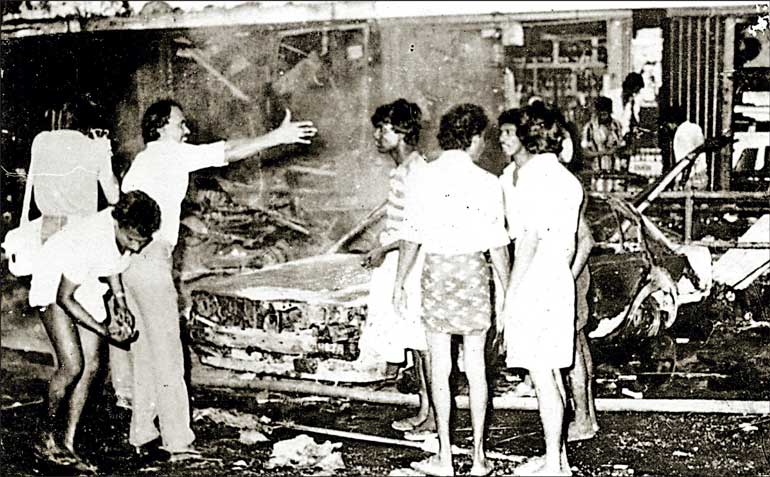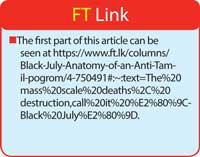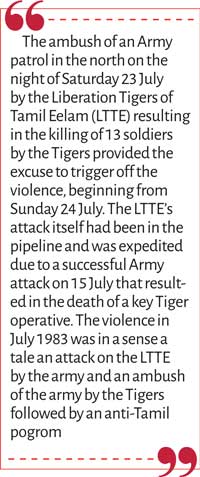Tuesday Apr 15, 2025
Tuesday Apr 15, 2025
Wednesday, 19 July 2023 00:50 - - {{hitsCtrl.values.hits}}

 The first part of this article published last week titled “Black July: Anatomy of an Anti-Tamil Pogrom” was a brief overview of the horrific anti-Tamil violence that engulfed the Sri Lankan nation in July 1983. The second part of this article being published this week will focus primarily on how “Black July” began in 1983. This detailed article is written with the aid of earlier writings to denote the 40th anniversary of the 1983 July anti-Tamil violence.
The first part of this article published last week titled “Black July: Anatomy of an Anti-Tamil Pogrom” was a brief overview of the horrific anti-Tamil violence that engulfed the Sri Lankan nation in July 1983. The second part of this article being published this week will focus primarily on how “Black July” began in 1983. This detailed article is written with the aid of earlier writings to denote the 40th anniversary of the 1983 July anti-Tamil violence.
As stated earlier the anti-Tamil violence of July 1983 was not a spontaneous mass uprising of the Sinhala people against the Tamil people. Prior to the outbreak of violence, there existed a pre-planned conspiracy to launch a widespread attack against Tamil life, limb and property on a massive scale. All it required was a powerful incident to be the provocative pretext to justify such an attack.
The ambush of an Army patrol in the north on the night of Saturday 23 July by the Liberation Tigers of Tamil Eelam (LTTE) resulting in the killing of 13 soldiers by the Tigers provided the excuse to trigger off the violence, beginning from Sunday 24 July. The LTTE’s attack itself had been in the pipeline and was expedited due to a successful Army attack on 15 July that resulted in the death of a key Tiger operative. The violence in July 1983 was in a sense a tale an attack on the LTTE by the army and an ambush of the army by the Tigers followed by an anti-Tamil pogrom.
Meesalai Army attack
In early July 1983 the Sri Lankan security forces stationed in the north received a tip-off that some Tigers were staying in a house within a coconut plantation at Allaarai, Meesaalai in the Thenmaratchy sector of the Jaffna peninsula. After verifying the information received, the Army launched an ambush. The soldiers commandeered a private mini-bus, concealed themselves inside and ventured into the interior of Meesalai.
This was at a time when the LTTE had only 32 members. Four of these namely Seelan, Aruna, Ganesh and Ananth were in the Meesalai safe house and taken by surprise when the Army attacked. After an exchange of fire, the Tigers began fleeing with their arms.
The soldiers gave chase and opened fire. Two of the four Tigers were hit. However they managed to take cover in a palmyrah grove. Ananth lost consciousness while Seelan who was then the Military Commander of the LTTE kept bleeding profusely. Seelan then ordered Aruna and Ganesh to shoot and kill him and Ananth and escape with the arms.
At that point of time the LTTE had a limited arsenal and regarded their firearms as very valuable assets. Aruna and Ganesh obeyed orders and shot dead both Seelan and Ananth. They fled from the spot and eventually evaded capture by hijacking a motorcycle and escaping.
Charles Anthony alias Seelan
The Army retrieved the two bodies and left. Subsequently the two Tigers were identified as Lucas Charles Anthony alias Seelan a.k.a. Aaseer of Trincomalee and Ramanathan Arulnathan alias Ananth of Myliddy. The security forces were jubilant over the death of Charles Anthony alias Seelan who was responsible for several attacks including the killing of two soldiers on Stanley Road in Jaffna town. He also led the successful Tiger assault on the Chavakachcheri Police station. Seelan had been appointed LTTE Military Commander by the Leader Veluppillai Prabhakaran.
The death of Seelan saddened and angered Prabhakaran very much. Not only was Seelan a comrade at arms but also a trusted confidante and friend of the Tiger supremo. Prabhakaran’s affection and regard for Seelan could be fathomed by two acts. Though a Hindu, Prabhakaran named his firstborn son Charles Anthony in honour of his friend. Also when the LTTE expanded and formed its first Infantry Division, it was named by Prabhakaran as the Charles Anthony Infantry Division.
It could be seen therefore that the death of Seelan hurt and infuriated Prabhakaran. The LTTE had been planning to stage a guerrilla ambush on an Army patrol for a long time. So when Seelan died, Prabhakaran ordered the Tigers to expedite the envisaged Army ambush. After hearing of Charles Anthony’s death, Prabhakaran told his men on 16 July that an attack on the Army must be launched within a week to avenge Seelan. Exactly a week later on 23 July the LTTE struck.
Thinnavely LTTE ambush
 After doing “recce” (reconnaissance) the LTTE had discovered some routine movements of the Army night patrols. It was decided to launch the attack in Thirunelvely called Thinnavely about two miles away from Jaffna town. The spot picked was about 150 metres south of the Post Box junction along the Jaffna-Palaly Road. The road had been already dug up for telecommunications wire laying. This made it convenient for the Tigers to bury landmines.
After doing “recce” (reconnaissance) the LTTE had discovered some routine movements of the Army night patrols. It was decided to launch the attack in Thirunelvely called Thinnavely about two miles away from Jaffna town. The spot picked was about 150 metres south of the Post Box junction along the Jaffna-Palaly Road. The road had been already dug up for telecommunications wire laying. This made it convenient for the Tigers to bury landmines.
After Seelan’s death LTTE supremo Prabhakaran appointed Sathasivam Selvanayagam alias Sellakkili of Kalviyankaadu as the Tiger Military Commander. The Thinnavely ambush was planned and supervised by Sellakkili with the support of Prabhakaran.
After Seelan and Ananth died the LTTE had only 30 full-time members including Prabhakaran. Of these 19 were involved in the T’vely attack. They were Prabhakaran, Sellakkili, Pulendran, Ponnammaan, Reggie, Ranjan Lala, Kittu, Santhosham, Victor, Appiah, Ganesh, Lingam, Albert, Basheer Kaakaa, Rajesh, Suppanna, Ramu, Gnanam and Raghu (Kundappa).
The four landmines were laid and the wires linked to the exploder were concealed on the back of the roof of a boutique facing the road. Sellakkili perched himself on the roof to explode the mines at the right time. The other Tiger cadres hid themselves behind brick walls in two groups on either side of the road.
The ‘Four Four Bravo’ patrol that had proceeded from the Mathagal military base consisted of 15 men travelling in a jeep and a TATA Benz half truck. The men were all from the 1st battalion of the Sri Lanka Light Infantry (SLLI). They were commanded by an old Anandian, 2nd Lt. Vass Gunawardane who had a sub-machine gun. The others had self-loading rifles and grenades.
When the two vehicles came near the landmines were set off by Sellakkili. They exploded on the right side of the jeep and in between the jeep and truck. Thereafter the Tigers started firing and lobbing grenades. The soldiers also retaliated. At the end of it all, 13 soldiers including Lt. Vass Gunawardane were dead. The only two Army survivors were Col. Perera and Lance Col. Sumathipala. From the Tiger side the sole casualty was Sellakkili, the newly-appointed Military Commander.
Sri Lanka Light Infantry
Once the news of the ambush became known soldiers of the SLLI went on the rampage. The then SLLI Commanding Officer Lt. Col. Upali Dharmaratne was either unwilling or unable to control them. The overall Jaffna Commander Brig. Lyle Balthazar too was unable to exert his authority and instil discipline.
The enraged soldiers went on a violent spree killing 51 civilians in Thinnavely and surrounding areas. This included a university lecturer Kala Parameswaran who was known to me personally. A mini-van carrying seven passengers was stopped at Manipay and all eight including the driver were lined up and shot dead in cold blood. Among these was my friend Wimalathasan, a human rights activist and Editor of the journal ‘Manithan’. Later on the then Army Commander Gen. Tissa “Bull” Weeratunga transferred the SLLI 1st battalion out of Jaffna. Lt. Col. Dharmaratne was replaced by Lt. Col. A.M.U. Seneviratne.
Senior DIG Sundaralingam
Meanwhile what was happening in the corridors of power in Colombo? I shall answer the question by reproducing an electronic mail sent to me by former DIG of Police Ramachandra Sundaralingam. Sunda, as he was known, was a very good friend to journalists of my generation in Sri Lanka. If we wanted a good law and order story, all we needed to do was to contact him.
Sundaralingam was serving as Senior DIG in charge of ranges at the time of the 1983 July anti-Tamil violence. Sunda later took up a post at the Interpol in Paris and became known as an expert in combatting the narcotics trade. After retirement he took up residence in Chennai, Tamil Nadu. Sunda and I were in regular contact via e-mail and telephone until his demise in December 2018.
While researching for an article in July 2020, I came across an e-mail sent by Sunda in July 2017. What happened then was that he wanted to talk to me about the 1983 July violence and telephoned my land line. I was away and did not respond promptly. An impatient Sunda then sent an e-mail summarising his thoughts. However, we did converse on the phone subsequently and discussed in detail the points mentioned in the e-mail. I also published the e-mail. However, I feel it is worthwhile reproducing that e-mail again as it sheds much light on what had happened then. Here it is:
Sunda’s e-mail
Dear DBS,
In case we miss each other’s call. Briefly the facts on the Darkest Chapter of the History of Sri Lanka July 1983;
1) Thinnavely LTTE ambush killed 13 soldiers 23 July 1983. Army Hq informed, Pres JR via Gen Attygalle ordered Army Com Weeratunge get to Jaffna immediately.
2) DIG Rajaguru in charge of NP called Rudra Rajasingham IGP and myself stating Army running berserk, Police were helpless.
3) Security Council meeting with all Service Chiefs, Air Force, Naval Commander except Army Chief already in Jaffna to monitor the happenings in Jaffna and elsewhere. IGP Rudra requested my presence at the meeting as Senior DIG Ranges overseeing NP DIG Rajaguru.
4) Gen Attygalle hourly discussion (3pm/7pm) with Army Chief Gen W in Jaffna situation deteriorating with Army revolt in Jaffna, damage to property and injury to several persons, Commander W unable to exercise any control .Gen Atty informs Pres JR on the ground situation, JR who in turn informs Gen Attygalle that Army soldiers be buried in Jaffna, as it happens in a war situation. When this message was conveyed to Gen W, his prompt reply, “Sir I will also be buried here, make arrangements to shift the bodies to their native places early.”
5) Security Council decides the bodies be flown to Katunayake Air Force base, after embalming be despatched to the 13 villages of the 13 soldiers. Police were instructed to organise 13 air conditioned Ambulances be in readiness at Katunayake on arrival of bodies from Jaffna. This arrangement was approved by Pres JR in his conversation with Gen Attygalle, I am an eye-witness to all these arrangements.
6) Direction received at Police HQ ambulance plan has been cancelled, the bodies will be brought to Ratmalana by air for common burial at Kanatte. In the meantime tension mounting in Colombo with large crowds heading for Kanatte.
7) IGP Rudra, DIG Ernest Perera and myself visited Kanatte, everything looked tensed up. I was able to sense the situation as serious. DIG Ernie P and I strongly advised IGP Rudra R to meet Pres JR immediately to impose curfew time around 9 p.m., otherwise the situation will get out of control. IGP left Kanatte to meet Pres JR at Ward Place. Curfew never declared until next evening by which time serious damage to Tamil persons and their property. Worst in the history of country. JR could have averted this situation but he failed to declare curfew. The big question is, who made the decision to bring the bodies to Kanatte for a common burial???? Minister Thondaman told me later it was Mr Cyril Mathew who insisted on Kanatte funeral. All this is history.”
 DIG (retd) Sundaralingam’s e-mail provides an insight into what happened then. The UNP Government headed by J.R. Jayewardene conducted a mass funeral at Kanatte for the 13 soldiers killed by the LTTE. Large crowds gathered at Kanatte on Sunday 24 July. Many were brought there in Government vehicles. The mood in Kanatte began turning ugly. This situation was further exacerbated by the speeches of prominent Buddhist monks.
DIG (retd) Sundaralingam’s e-mail provides an insight into what happened then. The UNP Government headed by J.R. Jayewardene conducted a mass funeral at Kanatte for the 13 soldiers killed by the LTTE. Large crowds gathered at Kanatte on Sunday 24 July. Many were brought there in Government vehicles. The mood in Kanatte began turning ugly. This situation was further exacerbated by the speeches of prominent Buddhist monks.
Esala Poya Day
The situation took a violent turn around dusk. Mobs began moving in the direction of Borella and Thimbirigasaya from Kanatte. Tamil homes and businesses were attacked and set on fire. As the Esala full moon shone brightly from a not-so-cloudy sky, clouds of smoke from burning Tamil establishments spiralled upwards.
The following Monday 25 July saw anti-Tamil violence spreading like wildfire. The plantation Tamil patriarch Saumiyamoorthy Thondaman known for his pithy comments later described the violence that followed Poya on Sunday as – “Sunday Sil, Monday Kill.”
Despite repeated entreaties by the then IGP Rudra Rajasingham to declare a curfew, President Jayewardene delayed imposing one until the following Monday evening. Even after a curfew was supposedly in force, the violence went on for three days peaking on Wednesday 27 July and ebbing on Thursday 28 July, the day that Indian Prime Minister Indira Gandhi sent then Indian Foreign Minister P. Narasimha Rao as her Special Emissary to Colombo.
Friday 29 July saw Colombo and suburbs being terrified by the rumour that the Tigers had come to town. The afternoon of that fateful ‘Koti Dawasa’ (Tiger Day) saw the goon squads massacring Tamils again after being ‘sure’ that no Tigers were in town. Finally 30 and 31 July saw the violence diminish gradually. By August the violence had ceased as international opinion and pressure compelled the J.R. Jayewardene regime to “normalise” the situation.
IGP Rudra Rajasingham
The then IGP Rudra Rajasingham a Tamil himself was distraught at the turn of events especially JR’s obstinacy in refusing to declare a curfew. According to family members, Rudra’s aged mother had urged her son to resign as a mark of protest but Rudra refused saying “he could not abandon the police force when the country was in its worst crisis.”
It may be recalled that Rudra Rajasingham should have been appointed IGP when Stanley Senanayake retired in 1978 after serving for long since 1970. Next to Rudra in terms of seniority was AC Lawrence. Both senior DIGs were Tamils. President J.R. Jayewardene appointed the third ranking senior DIG G.A.D.E.A. Seneviratne instead. It was only after Ana Seneviratne retired in 1982, that Rudra Rajasingham was appointed IGP.
“Sri Lanka: The Holocaust and After”
In this article’s first part published last week I had written that one of the best books that came out in the aftermath of the July ‘83 violence was “Sri Lanka: The Holocaust and After”. It was written by C.R. Hensman under the pseudonym L. Piyadasa. It was published by Marram Books in 1984. The following excerpts from that book highlight some aspects of the Black July violence:
“In Kelaniya, Industries Minister Cyril Mathew’s gangs were identified as the ones at work. The General Secretary of the government “union” the Jathika Sevaka Sangamaya (J.S.S.) was identified as the leader of gangs which wrought destruction and death all over Colombo and especially in Wellawatte, where as many as ten houses a street were destroyed. A particular U.N.P. municipal councillor of the Dehiwela-Mount Lavinia Municipality led gangs in Mount Lavinia. In the Pettah (the bazaar area, where 442 shops were destroyed and murders were committed) the commander was the son of Aloysius Mudalali, the Prime Minister’s right-hand man. And so on.”
“Thugs who worked regularly for the leaders of the U.N.P., the Ministers of State and Party Headquarters, and in some cases uniformed military personnel and police, were seen leading the attack. They used vehicles of the Sri Lanka Transport Board (Minister in charge, M. H. Mohammed) and other government departments and state corporations. Trucks of the Ceylon Petroleum Corporation’s Oil Refinery came from many miles away bringing the men who destroyed so much of Wellawatte. There is much other evidence of this sort.”
“In view of the quasi-governmental nature of the “action,” the killings that took place may have been difficult for the eye-witnesses to resist ... We have talked to people who were eye-witnesses of the killings – the beatings-to-death and burnings-alive in cold blood of individual Tamils seized, with never a case of police opposition, on the streets and in vehicles. Most people have read or heard the account, which we are convinced is authentic, of the Norwegian tourist who saw twenty people burnt alive in a minibus by one of these gangs. One of the most remarkable exploits of the “heroes” was the massacre, that day, in Welikade Prison of 35 detainees. All were Sri Lankan Tamils.”
“The pogrom continued less intensely in Greater Colombo for three more days, in spite of the curfew. On Tuesday, July 26th, some of the action squads were transported to Kandy, some 70 miles away, and that afternoon there was a similar sharp and quick action there before the curfew was declared at 6 p.m. It then moved further up-country, past towns like Matale (devastated) and Nawalapitiya towards Badulla and Nuwara Eliya. Hindu temples had been added to the hit list. Army action had resulted in over 60 per cent of Badulla’s city centre being reduced to rubble.”
“On the 27th, incredibly, the second massacre of Tamil political detainees and remand prisoners was successfully carried out. This time 18 were killed. There was more to come. For, as some of the Tamils began to trickle back to work towards the end of the week, their fellow-countryman, J.R. Jayewardene, spoke publicly for the first time on Thursday evening, justifying what had been done to the Tamils in South and central Sri Lanka, and uttering not a word of sympathy. On Friday, this provocative speech, and other actions, led to further arson and many more killings.”
(The writer can be reached at [email protected].)
Discover Kapruka, the leading online shopping platform in Sri Lanka, where you can conveniently send Gifts and Flowers to your loved ones for any event including Valentine ’s Day. Explore a wide range of popular Shopping Categories on Kapruka, including Toys, Groceries, Electronics, Birthday Cakes, Fruits, Chocolates, Flower Bouquets, Clothing, Watches, Lingerie, Gift Sets and Jewellery. Also if you’re interested in selling with Kapruka, Partner Central by Kapruka is the best solution to start with. Moreover, through Kapruka Global Shop, you can also enjoy the convenience of purchasing products from renowned platforms like Amazon and eBay and have them delivered to Sri Lanka.
Discover Kapruka, the leading online shopping platform in Sri Lanka, where you can conveniently send Gifts and Flowers to your loved ones for any event including Valentine ’s Day. Explore a wide range of popular Shopping Categories on Kapruka, including Toys, Groceries, Electronics, Birthday Cakes, Fruits, Chocolates, Flower Bouquets, Clothing, Watches, Lingerie, Gift Sets and Jewellery. Also if you’re interested in selling with Kapruka, Partner Central by Kapruka is the best solution to start with. Moreover, through Kapruka Global Shop, you can also enjoy the convenience of purchasing products from renowned platforms like Amazon and eBay and have them delivered to Sri Lanka.